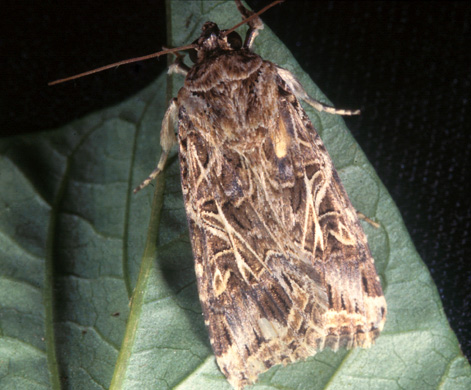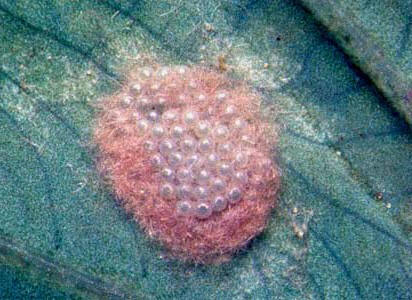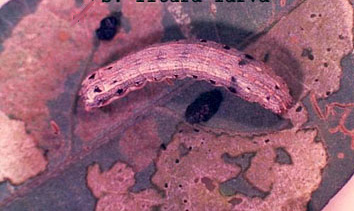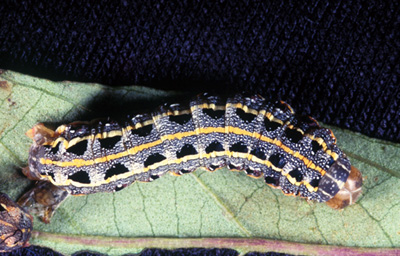|
|
Class |
Insecta |
|
Order |
Lepidoptera |
|
Family |
Noctuidae |
Cutworms
and armyworms attack a number of crops and may cause significant damage
depending on severity of infestation.
Worldwide.
On hatching, clusters of young larvae feed gregariously
by initially scraping the surface of the leaf. Later
instars
disburse and move on to other leaves and feed voraciously, producing large
irregular holes and may leave only the veins. High infestation causes severe
defoliation. Army worms quickly skeletonise leaves as they attack in clusters.
Armyworm
Egg. The eggs are laid in mass on the surface of
the leaves and covered with whitish scales. The egg stage lasts for 3 days.
Larva.
The larvae undergo several colour phases from green to almost
black. The larval stage lasts for about 9-14 days and usually has six
instars.
Pupa. Pupation
occurs in the soil and lasts for about 10 days.
Adults.
Adults
are smaller than other members of the cutworm-armyworm group, about 12 mm long
with a wing spread of 25 to 40 mm. Body and wings range from silvery-grey to
greyish-brown. Forewings have a lighter spot near the centre. Hindwings are
paler with darker borders, with a light band at the wing edges.
Cutworm
Egg. The eggs
are round, pearl-white, laid in mass on the ground or on the surface of the
leaves and covered with yellowish brown hairs. An egg mass contains about 100 to
300 hundred eggs. Egg hatches in 3-6 days.
Larva. The newly hatched
larvae are greenish with a dark longitudinal band on each side. The larvae are
pale greenish brown with dark markings and the body may have rows of dark spots
or may have transverse and longitudinal grey and yellow bands. They gradually
turn brownish black as they mature. The fully grown larva is stout
and cylindrical measuring 30-50 mm in length.
Pupa. The pupae are
reddish dark brown. Their legs and appendages are not capable of free
movement. Pupal stage lasts for about 12 days.
Adult. The adults
are brown moths with greyish brown forewings patterned with wavy markings and
the hindwings are transparent with a brown narrow band along the outer margins.
The eggs hatch after 3 days from egg deposition and take
about two weeks to reach the pupal stage. The larvae prefer moist sites. The
larvae hide during the day in the crevices found in the soil and plant residues
and become active during dusk to dawn. Pupation takes place in the soil in an
earthen cell. Pupation lasts for a week. The development of the armyworm/cutworm
from egg to adult takes about 3.5 to 4 weeks. The female S. exigua lays
up to 1,000 eggs while S. litura lays as many as 2,000-2,600.
Apart from sweetpotato, armyworms attack asparagus,
banana, cacao, corn, citrus, garlic, jute, kenaf, mulberry, onion, passion
fruit, sesame, sorghum, soybean, tobacco, rice, tomato, sugarcane, cotton,
beans, peanuts, castor oil plants, taro, wheat, white potato, a number of crops
under Cruciferae and Cucurbitaceae, grasses, and some broad leaf weeds.
Aside from the symptoms of damage, the
plant can also be inspected for the presence of eggs and feeding larvae.
Biological control
S. exigua and S. litura have several
natural enemies which can be used in biological control.
One effective control for S. exigua is the use of
a solution containing the virus nuclear polyhedrosis virus (NPV). This can
be applied to plants using the common backpack sprayer. There are also predators
that prey on this insect.
S. litura is preyed on by a number of predators
like ants, earwigs, pentatomid bugs and predaceous beetles. Telenomus
spodopterae Dodd and Telenomus remus Nixon can parasitise the eggs
and reduce its population. A species of entomogenous fungus, Nomuraea
rileyi infects
some larvae in the field. Caterpillars are susceptible to the biopesticide Bt
which at severe infestation could be used for spot application.
Chemical control
Azinphosethyl, carbaryl, chlorphyriphos, monocrotophous
phenthoate are recommended for armyworm control.
Amalin, D.M. and Vasquez, E. A. 1993. A handbook on
Philippine sweetpotato pests and their natural enemies. International Potato
Center (CIP), Los Baños, Philippines. 82 p.
Ames, T., Smit,
N.E.J.M., Braun, A.R., O’Sullivan, J.N., and Skoglund, L.G. 1996. Sweetpotato:
Major pests diseases, and nutritional disorders. International Potato Center
(CIP). Lima, Perú. 152 p.
Fliert, E.A. and Braun, A. R. 2000. Farmers Field School
for Integrated Crop Management of Sweetpotato - Field guides and technical
manual. International Potato Center and User’s Perspective With Agricultural
Research and Development.
Integrated Pest Management of Corn- Pocket Reference
Manual. (1987). Philippine-German Crop Protection Programme, Bureau of Plant
Industry, Department of Agriculture, San Andres, Malate, Manila, Philippines.
105 p.
Mau, R.F.L. and Martin Kessing, J.L. 1991. Spodoptera exigua.
http://www.extento.hawaii.edu.
10 July 2002.
PANS. 1978. Pest Control in Tropical Root Crop. Manual No. 4. Center for
Overseas Pest Research. London 235 p.
Shepard, B.M., Carner, G.R., Barrion, A.T., Ooi,
P.A.C. and van de Berg, H. 1999. Insects and their natural enemies associated
with vegetables and soybean in Southeast Asia. 108 p.
Vasquez,
E.A. and Sajise, C.E. 1990. Pests of sweetpotato: Insects, mites and diseases.
Philippine Root Crop Information Service, Philippine Root Crop Research &
Training Center. 65 p.
Contributed by: Erlinda
Vasquez and
Vilma Amante
|
Taxonomy
Economic
importance
Geographical
distribution
Damage
Morphology
Biology
and ecology
Host
range
Detection
and inspection
Management
References

A skeletonized leaf eaten by armyworm (A. Vera).

Larva
of S. litura (A. Braun).

Adult moth
of S. litura.

Larva
of S. exigua (A. Braun).

Larva
of S. exigua scraping on leaf (E. Vasquez).

Larva
of S. exigua (A. Braun).

Adult moth
of S. exigua (M. Shepard). |

